|
|

This section describes how to install and connect interface cards in the Catalyst 4224 Access Gateway Switch. This section contains the following topics:
 |
Warning Before you install, operate, or service the system, read Regulatory Compliance and Safety Information for Catalyst 4200 Series Access Gateway Switch. This guide contains important safety information you should know before working with the system. |
 |
Warning Only trained and qualified personnel should be allowed to install, replace, or service this equipment. |
You need these tools to install the interface cards:
The Catalyst 4224 has four slots reserved for WAN interface cards (WICs), voice interface cards (VICs), and T1/E1 multiflex voice/WAN interface cards (VWICs). You can install any combination of VICs, WICs, and VWICs in slots 1 and 2, but slot 3 accepts only VICs and VWICs. Slot 4 is filled with the high-density analog module when you first receive the switch.
 |
Caution You cannot swap an interface card without powering down the Catalyst 4224. If you fail to power down the switch, you will damage the interface cards. |
 |
Warning Do not work on the system or connect or disconnect cables during periods of lightning activity. |
 |
Warning This equipment is to be installed and maintained by service personnel only as defined by AS/NZS 3260 Clause 1.2.14.3 Service Personnel. |
 |
Warning Incorrect connection of this or connected equipment to a general purpose outlet could result in a hazardous situation. |
 |
Warning The telecommunications lines must be disconnected 1) before unplugging the main power connector and/or 2) while the housing is open. |
 |
Warning Hazardous network voltages are present in WAN ports regardless of whether power to the unit is OFF or ON. To avoid electric shock, use caution when working near WAN ports. When detaching cables, detach the end away from the unit first. |
 |
Warning To avoid electric shock, do not connect safety extra-low voltage (SELV) circuits to telephone-network voltage (TNV) circuits. LAN ports contain SELV circuits, and WAN ports contain TNV circuits. Some LAN and WAN ports both use RJ-45 connectors. Use caution when connecting cables. |
 |
Warning Network hazardous voltages are present in the BRI, fractional T1/T1, and Switched 56 cables. If you detach the cable, detach the end away from the router first to avoid possible electric shock. Network hazardous voltages are also present in the area of the BRI (RJ-45), fractional T1/T1 (RJ-48C), and Switched 56 (RJ-11 or RJ-48S) ports, regardless of whether power is off or on. |
 |
Warning To reduce the risk of fire, use only No. 26 AWG or larger telecommunication line cord. |
To install an interface card, perform these steps:
Procedure
Step 2 If the Catalyst 4224 is on, you must power it off.
 |
Caution To channel ESD voltages to ground, do not unplug the power cable. |
Step 3 Use either a number 2 Phillips screwdriver or a small flat-blade screwdriver to loosen the screws of the blank faceplate and remove the faceplate from the interface slot where you plan to install the card. Save the faceplate for future use.
Step 4 Align the card with the cable guides in the interface slot and slide the card gently into the slot.
Figure 4-1 shows how to insert a VIC or WIC into slot 2 of the Catalyst 4224.
 |
Warning Blank faceplates and cover panels serve three important functions: they prevent exposure to hazardous voltages and currents inside the chassis; they contain EMI that might disrupt other equipment; and they direct the flow of cooling air through the chassis. Do not operate the system unless all modules, faceplates, front covers, and rear covers are in place. |
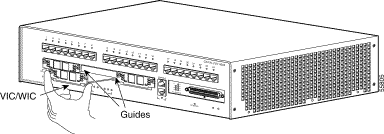
Step 5 Push the card into place until you feel its edge connector mate securely with the connector in the interface slot.
Step 6 Tighten the card's captive mounting screws into the holes in the Catalyst 4224 faceplate using a Phillips or a flat-blade screwdriver.
Step 7 Reinstall the network interface cables and power on the switch.
These sections describe how to connect the supported VWICs, WICs, and VICs:
After you connect the cards, refer to the Catalyst 4224 Access Gateway Switch Software Configuration Guide.
This section describes the procedures for connecting the following WAN interface cards:
This section describes how to connect and verify the status of the one-port 56/64-kbps Data Service Unit/Channel Service Unit (DSU/CSU) interface cards (WIC-1DSU-56K).
Use a straight-through RJ-48S-to-RJ-48S or the straight-through RJ-48C-to-RJ-48C cable that shipped with the Catalyst 4224.
To connect the one-port 56/64-kbps DSU/CSU card, follow these steps:
Procedure
Step 2 Connect one end of the cable to the 56/64-kbps port of the card, as shown in Figure 4-2.
Step 3 Connect the other end of the cable to the RJ-48S wall jack, as shown in Figure 4-2.

Step 4 Power on the Catalyst 4224.
Step 5 Verify that the CD LED is green, indicating that the internal DSU/CSU is communicating with another DSU/CSU.
Table 4-1 describes the 56/64-kbps WAN interface card LEDs.
| LED | Description |
|---|---|
TD | Green indicates that data is being transmitted to the DTE interface. |
RD | Green indicates that data is being received from the DTE interface. |
LP | Yellow indicates that the internal DSU/CSU is in loopback mode. This LED is off during normal operation. |
AL | Yellow indicates that one of these alarm conditions is present: no receive signal, loss of frame signal from the remote station, or an out-of-service signal from the remote station. This LED is off during normal operation. |
CD | Green indicates that the internal DSU/CSU in the WIC is communicating with another DSU/CSU. This LED is off during normal operation. |
This section describes how to connect and verify the status of the one-port T1/FT1 DSU/CSU interface card (WIC-1DSU-T1).
Use a straight-through RJ-48S-to-RJ-48S or the straight-through RJ-48C-to-RJ-48C cable that shipped with the Catalyst 4224.
To connect the one-port T1/FT1 card, follow these steps:
Procedure
Step 2 Connect one end of the cable to the T1/FT1 port of the card, as shown in Figure 4-3.
Step 3 Connect the other end of the cable to the RJ-48S wall jack, as shown in Figure 4-3.
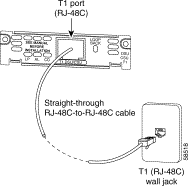
Step 4 Power on the Catalyst 4224.
Step 5 Verify that the CD LED is green, indicating that the internal DSU/CSU in the card is communicating with another DSU/CSU.
Table 4-2 describes the T1/FT1 WAN interface card LEDs.
| LED | Description |
|---|---|
LP | Yellow indicates that the internal DSU/CSU is in loopback mode. This LED is off during normal operation. |
AL | Yellow indicates that one of these alarm conditions is present: no receive signal, loss of frame signal from the remote station, or an out-of-service signal from the remote station. This LED is off during normal operation. |
CD | Green indicates that the internal DSU/CSU in the WIC is communicating with another DSU/CSU. This LED is off during normal operation. |
This section describes how to connect and verify the status of two-port asynchronous/synchronous (A/S) serial cards (WIC-2A/S).
 |
Note The Catalyst 4224 does not support asynchronous mode operation at this time. |
The two-port A/S serial card has "smart" serial ports. The serial cable attached to one of the card's ports can determine the electrical interface type and mode (DTE or DCE).
Six types of serial cables (also called serial adapter cables or serial transition cables) are available from Cisco Systems for use with the two-port A/S serial card:
All serial cables have a universal plug at the interface card end. The network end of each cable provides the physical connectors that are most commonly used for the interface. For example, the network end of the EIA/TIA-232 serial cable is a DB-25 connector, which is the most widely used EIA/TIA-232 connector.
All serial interface types, except EIA-530, are available in DTE or DCE mode: DTE with a plug connector at the network end and DCE with a receptacle at the network end. The V.35 assembly is available in either mode with either gender at the network end. The EIA/TIA-530 assembly is available in DTE only.
After you install the two-port A/S serial card, use the appropriate serial cable to connect the serial port on the card to one of the following types of equipment (see Figure 4-4):
To connect the two-port A/S serial card, follow these steps:
Procedure
Step 2 Connect one end of the appropriate serial cable to a DB-60 port on the card, as shown in Figure 4-4.
Step 3 Connect the other end of the cable to the appropriate type of equipment, as shown in Figure 4-4.
Step 4 Power on the Catalyst 4224.
Step 5 Verify that the CONN LED goes on, indicating that the serial port on the card detects the WAN serial connection.

Table 4-3 describes the two-port A/S serial interface card LED.
| LED | Description |
|---|---|
CONN | Green indicates that the serial port detects a WAN serial connection. |
This section describes how to connect and verify the status of the 1- and two-port serial cards (WIC-1T and WIC-2T).
 |
Note The Catalyst 4224 does not support asynchronous mode operation at this time. |
The two-port A/S serial card has "smart" serial ports. The serial cable attached to one of the card's ports can determine the electrical interface type and mode (DTE or DCE).
Six types of serial cables (also called serial adapter cables or serial transition cables) are available from Cisco Systems for use with the two-port A/S serial card:
All serial cables provide a universal plug at the interface card end. The network end of each cable provides the physical connectors that are most commonly used for the interface. For example, the network end of the EIA/TIA-232 serial cable is a DB-25 connector, which is the most widely used EIA/TIA-232 connector.
All serial interface types except EIA-530 are available in the following DTE or DCE mode: DTE with a plug connector at the network end and DCE with a receptacle at the network end. The V.35 assembly is available in either mode with either gender at the network end. The EIA/TIA-530 assembly is available in DTE only.
After you install the two-port A/S serial card, use the appropriate serial cable to connect the serial port on the card to one of the following types of equipment (see Figure 4-5):
To connect either the 1- or two-port serial card, follow these steps:
Procedure
Step 2 Connect one end of the appropriate serial cable to a DB-60 port on the card, as shown in Figure 4-5.
Step 3 Connect the other end of the cable to the appropriate type of equipment, as shown in Figure 4-5.
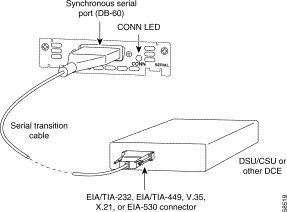
Step 4 Power on the Catalyst 4224.
Step 5 Verify that the CONN LED goes on, indicating that the serial port on the card detects the WAN serial connection.
Table 4-4 describes the serial WAN interface card LED.
| LED | Description |
|---|---|
CONN | Green indicates that the serial port detects the WAN serial connection. |
This section describes how to connect the following voice interface cards:
This section describes how to connect and verify the status of the two-port Foreign Exchange Station (FXS) voice interface card (VIC-2FXS or VIC-2FXS-EU).
The two-port FXS voice interface card has two jumper headers (W3 and W4) that you can use to set loop-start or ground-start mode. One jumper configures each FXS port. The default setting is loop start. In the default setting, jumpers are placed over positions 2 and 3 of headers W3 and W4.
Most modern central office (CO) equipment, such as the DMS-100 and 5ESS switches, provides the calling party control (CPC) and Ring on Seize (RoS) features on loop-start lines. CPC provides faster disconnection, and RoS minimizes glare (collision of inbound and outbound calls on the same interface). If your CO does not provide these features on loop-start wires, you may want to configure the FXS card for ground-start operation instead by moving the jumpers to positions 1 and 2.
For proper operation, you must configure both jumpers identically. In most cases, the jumper setting should have little or no effect on operation.
 |
Note Jumper settings apply only to VIC-2FXS. |
Use a standard RJ-11 modular telephone cable to connect the two-port FXS card to the PSTN or PBX through a telephone jack.
To connect the two-port FXS card, follow these steps:
Procedure
Step 2 Connect one end of the cable to one of the RJ-11 ports of the card, as shown in Figure 4-6.
Step 3 Connect the other end of the cable to the RJ-11 wall jack, as shown in Figure 4-6.
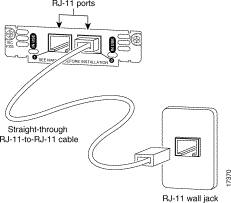
Step 4 Power on the Catalyst 4224.
Step 5 Check that the LED is green.
Table 4-5 describes the FXS voice interface card LED.
| LED | Description |
|---|---|
IN USE | Green indicates that an off-hook has been detected. Off indicates that an on-hook has been detected. |
 |
Caution Connect only an FXS interface that is approved for use in your country to the PSTN. Otherwise, connect the FXS interface only to a PBX. |
This section describes how to connect and verify the status of an eight-port RJ21 FXS module (WS-U4604-8FXS).
This section describes the following topics:
Figure 4-7 shows examples of the RJ-21 telco connector for the RJ-21 port on the eight-port FXS module. The connectors are available in three cable-to-connector orientations: 90 degrees, 110 degrees, and 180 degrees.
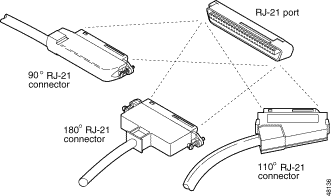
Because 90-degree RJ-21 connectors have only one screw, they require additional support to hold one side of the connector to the module. Cisco supplies a bracket and a velcro strap in the accessory kit (see Figure 4-8) for this purpose.
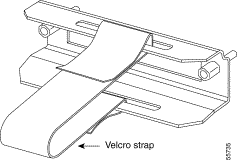
To attach the bracket to the eight-port FXS module, follow these steps:
Procedure
Step 2 Align the screws on the bracket with the holes on the eight-port FXS module, and then tighten them.
Step 3 Align the screw on the 90 degrees RJ-21 connector with the appropriate screw top on the bracket, and then tighten the screw.
Step 4 Attach the velcro strap as illustrated in Figure 4-9.
Use a standard RJ-21 Category 5 telco connector and cable to connect the eight-port FXS module jack to the breakout box.
To connect the eight-port RJ21 FXS module, follow these steps:
Procedure
Step 2 Connect one end of the RJ-21 cable to a telco RJ-21, as shown in Figure 4-9.
Step 3 Connect the other end of the cable to the breakout box or patch panel, as shown in Figure 4-9.
Step 4 Power off the Catalyst 4224.
Step 5 Verify that the HDA LED is green. This LED indicates that Cisco IOS is running.
 |
Caution Do not directly connect Octel voice mail servers to the eight-port FXS module. You must first connect the servers to a patch panel. Every alternate output port on the Octel voice mail server is a pair of grounds. (The ring-tip pairs are not defined as port 0, port 1, and so on. Instead, they are defined as port 0, ground/ground, port 1, ground/ground, and so on.) Connecting these grounds directly to the FXS module results in shorting every alternate port on the module to ground. |
 |
Warning If the symbol of suitability with an overlaid cross appears above a port, you must not connect the port to a public network that follows the European Union standards. Connecting the port to this type of public network can cause severe injury or damage your router. |
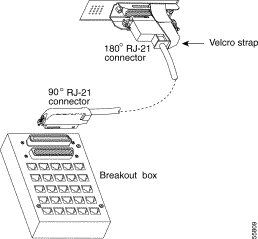
Table 4-6 describes the eight-port RJ21 FXS module link LED.
| LED | Description |
|---|---|
Link | Green indicates that the telephone or fax machine is off-hook. Off indicates that the port is not active (connected device is on-hook) or that the link is not connected |
Figure 4-10 shows the pinout convention for the telco RJ-21 (tip and ring on 25 pairs). The top row is ring, the bottom row is tip. For the eight-port FXS module, only the eight pairs to the right are used. The middle set of eight pairs is shorted together but not to ground.

See Table B-3 in "Connector and Cable Specifications," for a mapping of the RJ-21 pinouts for the eight-port FXS module connector.
This section describes how to connect and verify the status of the two-port FXO voice interface cards (VIC-2FXO, VIC-2FXO-EU).
The two-port FXO voice interface card includes two jumper headers (W3 and W4) that you can use to set loop-start or ground-start mode. One jumper configures each FXO port. The default setting is loop start. In the default setting, jumpers are placed over positions 2 and 3 of headers W3 and W4.
For proper operation, you must configure both jumpers identically. In most cases, the jumper setting should have little or no effect on operation.
 |
Note This jumper setting does not apply to VIC-2FXO-EU. |
Use a standard RJ-11 modular telephone cable to connect the two-port FXO card to the PSTN or PBX through a telephone jack. To connect the two-port FXO card, follow these steps:
Procedure
Step 2 Connect one end of the cable to one of the RJ-11 ports of the card, as shown in Figure 4-11.
Step 3 Connect the other end of the cable to the RJ-11 wall jack, as shown in Figure 4-11.

Step 4 Power on the Catalyst 4224.
Step 5 Check that the IN USE LED is green, indicating that the line is in use.
Table 4-7 describes the FXO voice interface card LED.
| LED | Description |
|---|---|
IN USE | Green indicates that the line is in use. |
The VIC-2FXO-EU voice interface card is intended for use in Europe. In countries where PSTNs do not use RJ-11 wall jacks, use a suitable adapter to convert the plug on an RJ-11 modular cable to the type of wall outlet connector that is used in your country. These adapters are not sold by Cisco Systems but are available from other vendors.
 |
Caution Connect only an FXO interface that is approved for use in your country to the PSTN. Otherwise, connect the FXO interface only to a PBX. Connections from the PBX to the PSTN are permitted. |
This section describes how to connect and verify the status of the two-port ISDN BRI cards (VIC-2BRI-S/T-TE).
Use the straight through RJ-48C-to-RJ-48C cable that shipped with your Catalyst 4224.
To connect the two-port ISDN BRI card, follow these steps:
Procedure
Step 2 Connect one end of the cable to one of the RJ-48C ports of the card, as shown in Figure 4-12.
Step 3 Connect the other end of the cable to one of the RJ-48C S/T ports on an NT1 device, as shown in Figure 4-12.
 |
Caution To prevent damage to the switch, be sure to connect the cable to the BRI connector only. Do not connect the cable to any other RJ-48C connector. |

Step 4 Power on the Catalyst 4224.
Step 5 Check that the OK LED is green, indicating that the card is connected to an ISDN network.
Table 4-8 describes the ISDN BRI voice interface card LEDs.
| LED | Description |
|---|---|
B1 | Green indicates that the call is active on the B1 channel. |
B2 | Green indicates that the call is active on the B2 channel. |
OK | Green indicates that the interface card is connected to an ISDN network. This LED is on during normal operation. |
This section describes how to connect the following interface cards:
This section describes how to connect and verify the status of the one-port multiflex trunk interface cards (VWIC-1MFT-T1, VWIC-1MFT-E1, or VWIC-1MFT-G703).
Use the straight-through RJ-48C-to-RJ-48C cable that shipped with the Catalyst 4224.
To connect the one-port multiflex trunk interface card, follow these steps:
Procedure
Step 2 Connect one end of the cable to the RJ-48C port of the card, as shown in Figure 4-13.
Step 3 Connect the other end of the cable to the RJ-48C wall jack at your site, as shown in Figure 4-13.
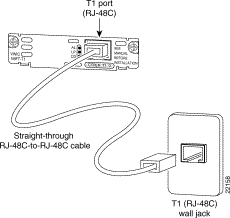
Step 4 Power on the Catalyst 4224.
Step 5 Verify that the CD LED is green, indicating that the card's internal DSU/CSU is communicating with the DSU/CSU at the T1 or E1 service provider's CO.
Table 4-9 describes the one-port multiflex trunk interface card LEDs.
| LED | Description |
|---|---|
AL | Yellow indicates that there is a local or remote alarm state. This LED is off during normal operation. |
LP | Yellow indicates that a loopback or line state has been detected or has been manually set by the user. This LED is off during normal operation. |
CD | Green indicates that a carrier has been detected and that the internal DSU/CSU in the card is communicating with another DSU/CSU. This LED is on during normal operation. |
This section describes how to connect and verify the status of the two-port multiflex trunk interface cards (VWIC-2MFT-T1, VWIC-2MFT-E1, VWIC-2MFT-T1-DI, VWIC-2MFT-E1-DI, or VWIC-2MFT-G703).
Use the straight-through RJ-48C-to-RJ-48C cable that shipped with the Catalyst 4224.
To connect the two-port multiflex trunk interface card, follow these steps:
Procedure
Step 2 Connect one end of the cable to one of the RJ-48C ports of the card, as shown in Figure 4-14.
Step 3 Connect the other end of the cable to the T1 or E1 (RJ-48C) wall jack at your site, as shown in Figure 4-14.
Step 4 Turn on power to the switch.
Step 5 Verify that the CD LED is green, indicating that the card's internal DSU/CSU is communicating with the DSU/CSU at the T1 or E1 service provider CO.
Table 4-10 describes the two-port multiflex interface card LEDs.
| LED | Description |
|---|---|
AL | Yellow indicates that there is a local or remote alarm state. This LED is off during normal operation. |
LP | Yellow indicates that a loopback or line state has been detected or has been manually set by the user. This LED is off during normal operation. |
CD | Green indicates that a carrier has been detected and that the internal DSU/CSU in the card is communicating with another DSU/CSU. This LED is on during normal operation. |
![]()
![]()
![]()
![]()
![]()
![]()
![]()
![]()
Posted: Wed Jul 24 03:22:22 PDT 2002
All contents are Copyright © 1992--2002 Cisco Systems, Inc. All rights reserved.
Important Notices and Privacy Statement.